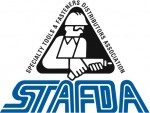STAFDA 2012 Session Preview: Situational Leadership
Pete Land, President, Peter A. Land Associates, Inc.
 |
 |
|
International management consultant/trainer/coach Peter A. Land will discuss “Situational Leadership” from 1:00 to 2:30 and again from 3:00 to 4:30 p.m., Sunday, Nov. 4 in the West Building of the Orange County Convention Center. |
Passionate, Proactive Teamwork — A Key Secret to Business Success
Have you ever noticed how some businesses, regardless of the industry, just seem to “make it” and succeed by every measure of merit? Whether a fresh-faced start-up or an old-timer, they do well both in good times and bad. Whereas other companies, in the same market, teeter
on the feather-edge of disaster until one day they unceremoniously slip below the waves. Have you ever wondered why?
During my 50-plus-year study of hundreds of organizations on four continents, I’ve discerned something that exists in the culture of successful companies which does not exist, or is only given lip service, in failing organizations. That key ingredient is passionate, proactive teamwork. The purpose of this article is to disassemble this jewel — passionate, proactive teamwork — examine all its facets, reassemble it and put it in your pocket.
First, let’s take a dispassionate look at the meaning of the word “passion.” One definition in the dictionary is “boundless enthusiasm.” Passionate, proactive team members are not bound by a position description or a time clock; they have no “on-off switch.” They exhibit unbridled
passion and enthusiasm both on the job and in their personal life.
What is proactive?
The word “proactive” is a relatively new concept, having only made it to the Random House Dictionary in 1987. Proactive means “serving to prepare for, intervene in or control an unexpected occurrence or situation, especially a negative or difficult one.” For generations we only used “passive” or “active,” which is binary thinking.
Here’s one way to discern the important differences between “passive,” “active” and “proactive.” In business, a passive person’s mantra is “I ain’t gotta do it — it’s not my job.” Passive people tend to be spring-loaded to the off position and are usually the first recipients of a pink slip when layoffs occur. They tend to go to work late, reluctantly, and go home early, enthusiastically.
Active people will do their job and do it well. They are generally reliable and will respond to requests for support. They will do what is expected, but they tend to stop working at the last period in their job description. Active people dominate the center of mass in most organizations, and we need them.
In glaring contrast are those blessed few who are wired for “proactivity.” They do not view their job descriptions as a list of “have-to’s,” but rather as a loosely structured platform to stand on to reach for the mission — the sole justification for the organization’s existence.
Proactive team members anticipate a need and respond without (or before) being asked. They have a mind-set of “prevent” as opposed to “repair.” They rarely get caught by surprise, because they are thinking so far ahead that they discern, analyze and solve a potential problem long before most folks are even aware such a troubling trend exists. Proactive people are strangers to crisis management because most of their best work is accomplished with measured deliberation in the future.
Education vs. training
Before we examine the final word “team,” we need to clarify two key concepts. There is a profound difference between education and training. Education usually takes place in the classroom and is basically the transfer of concepts and principles; the output of education is knowledge. We demonstrate our knowledge by taking tests, writing term papers, etc. Education is the glue that holds civilized societies together.
Training, on the other hand, is the transfer of skills and usually takes place on the job. Here is a key point — the output of training is performance, which is the ability to actually accomplish a task successfully. For example, when I was in Air Force pilot training in the late 1950’s, half of each day was spent in a classroom learning the concepts and principles of aerodynamics, but the other half was spent in a single-engine jet plane developing the skill of landing the aircraft. Sadly, we had a few people who made straight A’s in the classroom, but they could never master the skill of landing a jet. They are not pilots today because they cannot fly (performance).
Education (knowledge) without training (skill building) can lead to great frustration. I’ve heard this lament from countless managers over the years. “I attended the lecture and read the book (education), but I’m still having big problems on the job with my employees with feedback, coaching, training, counseling, delegation, discipline, etc. That’s the sad face of a person who was educated but not trained.
Equally unacceptable is a system which provides only training with minimal education. This process tends to create automatons or human robots that perform their tasks mechanically with little depth of knowledge to help deal with the unexpected or the unusual.
Bottom line — education is necessary to establish a broad base of knowledge which can be viewed as “what and why.” Training is needed to translate knowledge into skills, which is the “how, when and where.” These two different, but equally important components, are absolutely necessary to produce valued goods and services for the marketplace.
Putting it together — teamwork
Finally, we are ready to examine what the word “team” really means. The best definition of team I’ve seen is in the excellent book, The Wisdom of Teams, by Jon R. Katzenbach and Douglas K. Smith (New York: Harper Collins, 1994). “A team is a small number of people with complementary skills who are committed to a common purpose, performance goals, and approach for which they hold themselves mutually accountable.” Notice it cites “complementary skills” as opposed to knowledge.
In sports, complementary skills means, “I throw, you catch.” This definition is so profound that I devoted much of a chapter in my book, How To Build A Winning Team (And Have Fun Doing It!) to fully unpacking this insightful definition.
Now that we have examined all the puzzle pieces, let’s see how beautifully these components fit together to create passionate, proactive teamwork for our department, for other departments in our company, for our customers and our customers’ customers. Yes, we should always focus our impact at least one level above and beyond our immediate customers, be they internal or external.
Passionate, proactive teams realize that the lessons of yesterday should help us be one day better today. They don’t focus on the “if” question, i.e., “If we can improve?” or “If we can become more effective and efficient?” That is binary thinking – the choices are always yes or no.
Passionate, proactive team members automatically assume the answer to an “if” question is yes, and focus on the “how” question.
When the “how” question is on the table, it taps that endless reservoir of creativity, risk taking, innovation and problem solving which make up the life blood of organizations that just seem to “make it” and succeed by every measure of merit.
How can you identify a passionate, proactive team member? It’s easy. They have a balanced life with a harmonious dedication to their family, their faith, their health, their future and their organization’s mission. CS
For up-to-the-minute STAFDA Convention news and exhibitor listings, visit www.stafda.org.
Peter A. Land, MS, CSP, CMC, CPCM is an international management consultant, trainer, coach and author. His program includes the four reasons for organizational performance problems, leadership models that improve productivity and how to adjust leadership styles to different situations.
MORE INFO: www.peteland.com
















